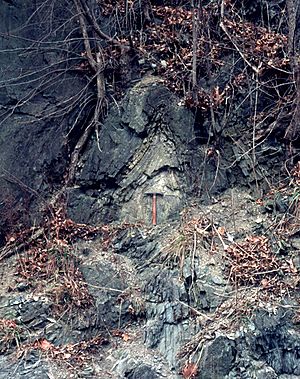Wills Creek Formation facts for kids
Quick facts for kids Wills Creek FormationStratigraphic range: Silurian |
|
|---|---|

A tight fold in the Wills Creek Formation, along Route 22, Neff, Huntingdon County, Pennsylvania
|
|
| Type | sedimentary |
| Underlies | Tonoloway Formation |
| Overlies | Bloomsburg Formation and Williamsport Formation |
| Lithology | |
| Primary | Sandstone, shale |
| Other | Siltstone, limestone, dolomite |
| Location | |
| Region | Appalachian Mountains |
| Extent | Pennsylvania, Maryland, Virginia, West Virginia |
| Type section | |
| Named for | Wills Creek at Cumberland, Allegany County, Maryland |
| Named by | P. R. Uhler, 1905 |
The Wills Creek Formation is a special layer of rock found in the ground across Pennsylvania, Maryland, Virginia, and West Virginia. This rock layer formed during the Silurian Period, which was a very long time ago. Geologists, who are scientists who study rocks, use the term "formation" to describe a specific set of rock layers that have similar features and were formed around the same time.
Contents
What is the Wills Creek Formation?
The Wills Creek Formation is mostly made of a type of rock called shale, which is often greenish-gray. It also has layers of limestone and sandstone. Sometimes, you can find other rocks like siltstone and dolomite within it. Near the bottom of this rock layer, you might see red shale and siltstone.
This rock formation is quite thick! In Maryland, it can be between 450 and 600 feet thick. That's like stacking 45 to 60 school buses on top of each other! In Pennsylvania, it's a bit thicker, ranging from 445 to 620 feet. The Wills Creek Formation forms the ground in the valley around Lewistown, Pennsylvania.
What kinds of fossils are found?
Scientists have found fossils in the Wills Creek Formation. These fossils come from the Pridoli and Ludlow epoch periods, which were about 422.9 to 418.1 million years ago.
However, there aren't a huge number of fossils in this rock. Scientists have mostly found tiny fossils called conodonts in the Wills Creek Formation in Virginia. Conodonts are small, tooth-like fossils from ancient, eel-like creatures.
Where can you see the Wills Creek Formation?
You can see good examples of the Wills Creek Formation in a few places:
- At Wills Creek near Cumberland, Allegany County, Maryland. This is where the formation got its name.
- At Roundtop Hill in Maryland, along the railroad tracks.
How old is the Wills Creek Formation?
Scientists use special methods to figure out the age of rock layers. They know that the Wills Creek Formation was formed during the Silurian Period. It sits on top of another rock layer called the Bloomsburg Formation and is found below the Tonoloway Formation. This helps scientists understand the order of rock layers and how old they are.
What is the Wills Creek Formation used for?
The Wills Creek Formation is not very strong, so it's not used for building things like houses or roads. It's mostly suitable for simple uses, like filling in land.
Images for kids


